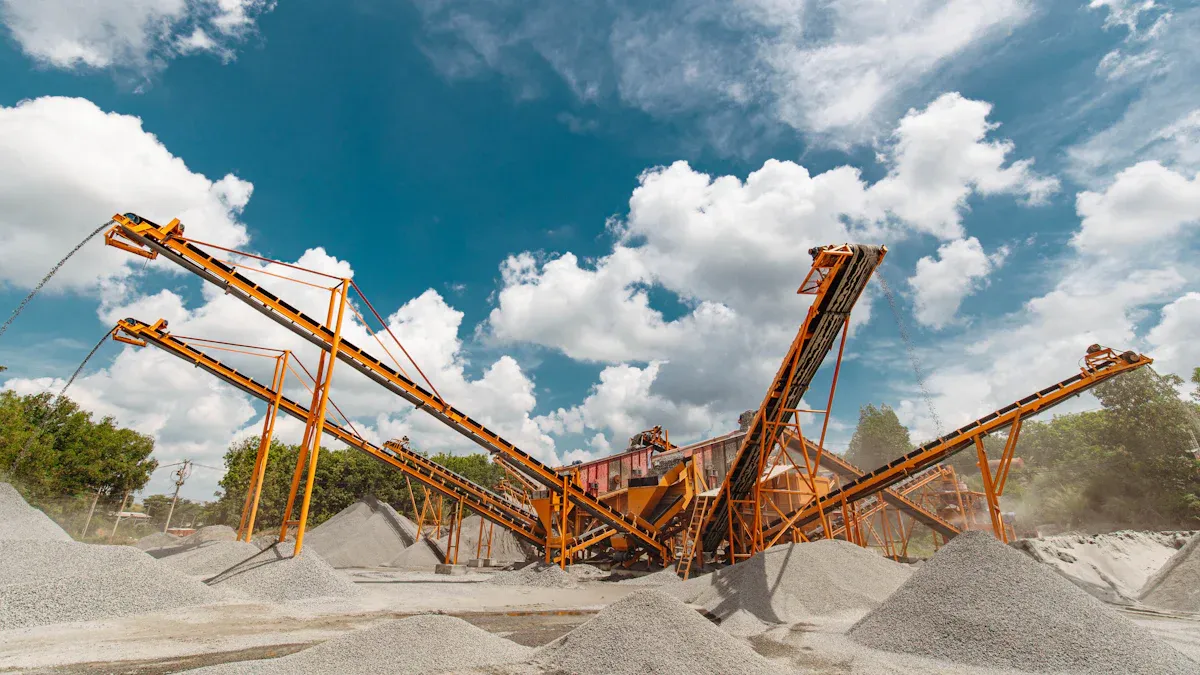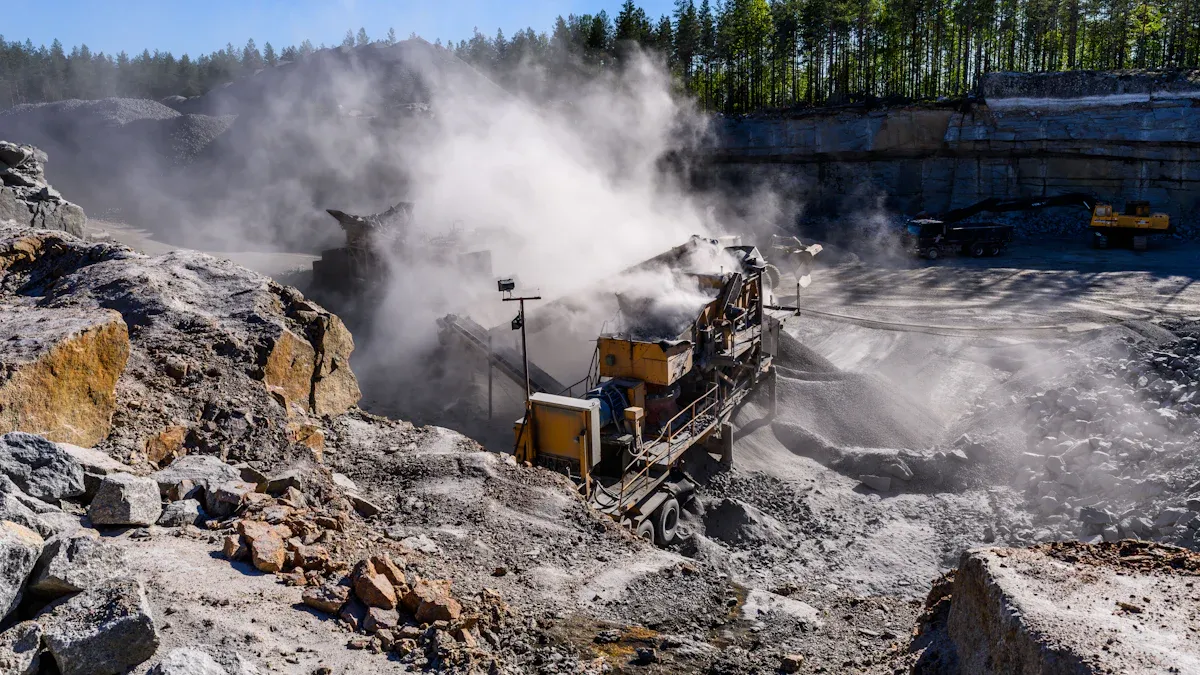
Timely replacement of your cone crusher liner keeps your equipment running efficiently. Delaying this maintenance task reduces production and causes excessive wear on critical components. You risk mechanical failures that halt operations and increase repair costs. Monitoring wear and replacing the liner when needed ensures consistent output and protects your crusher from damage.
A noticeable drop in production is one of the first signs that it’s time to change cone crusher liners. When your crusher’s output decreases by 10% or more, it indicates that the liners have worn down and are no longer performing efficiently. Worn liners reduce the crusher’s ability to break down material effectively, leading to slower processing times and lower overall throughput. Monitoring production levels regularly helps you identify these changes early. By acting promptly, you can avoid further losses and maintain consistent performance.
Inspecting the liner thickness is another critical step in determining when to replace your cone crusher liners. Over time, liners wear down due to constant contact with abrasive materials. When the liner thickness reaches the manufacturer’s recommended minimum, it’s time for a replacement. Ignoring this can lead to uneven wear, which affects the crusher’s efficiency and shortens the life of other components. Look for visible signs of wear, such as cracks, grooves, or uneven surfaces. Regular inspections ensure you catch these issues before they escalate.
The feed material plays a significant role in the performance of your cone crusher liners. A well-graded feed ensures optimal crushing and even wear on the liners. If the feed size becomes too small, it can cause uneven wear and reduce production due to poor reduction ratios. On the other hand, oversized feed material can lead to excessive wear at the top of the liners and lower throughput. To maintain consistent performance, monitor the feed gradation and adjust as needed. Ensuring a balanced and well-graded feed not only extends the life of your liners but also improves overall crusher efficiency.
Before replacing cone crusher liners, preparation is essential to ensure a smooth and safe process. Start by shutting down the crusher and disconnecting it from the power supply. This step prevents accidental activation during the replacement. Wear appropriate personal protective equipment (PPE), including gloves, safety glasses, and a hard hat, to protect yourself from potential hazards.
Inspect the work area for any loose materials or debris that could cause accidents. Use proper tools and lifting equipment to handle the liners, as they are heavy and difficult to move manually. Review the manufacturer’s guidelines for specific instructions on liner replacement. Following these safety protocols minimizes risks and ensures a safe working environment.
Removing the old liners requires careful handling to avoid damaging the crusher. Begin by loosening the bolts or fasteners that secure the liners in place. Use the appropriate tools to avoid stripping or breaking the bolts. Once the fasteners are removed, lift the worn-out liners using a crane or hoist. Ensure the liners are balanced during lifting to prevent accidents.
Inspect the crusher’s internal components for any signs of wear or damage. Clean the surfaces where the new liners will be installed. Removing debris and residue ensures a proper fit and prevents uneven wear in the future. Proper removal of the old liners sets the stage for a successful installation.
Installing new liners requires precision and attention to detail. Position the liners carefully inside the crusher, ensuring they align with the mounting points. Use a crane or hoist to lower the liners into place. Secure the liners by tightening the bolts or fasteners according to the manufacturer’s specifications. Over-tightening can cause stress on the liners, while under-tightening may lead to movement during operation.
Check the alignment of the liners to ensure they fit snugly against the crusher’s surfaces. Misaligned liners can cause uneven wear and reduce the crusher’s efficiency. Proper installation extends the life of the liners and maintains optimal cone crusher performance.
After installing the new liners, testing the crusher ensures everything functions correctly. Start the crusher and monitor its operation for unusual noises or vibrations. Check the feed material to ensure it flows smoothly through the crusher. Adjust the settings as needed to achieve the desired feed gradation and throughput.
Research shows that analyzing the diameter, angles, and rotational speed of the moving cone helps verify optimal performance. Using advanced tools like DEM simulation can identify the best combinations of these parameters. This process improves productivity and ensures the crusher operates reliably. Regular testing and adjustments maintain the efficiency of your cone crusher liners and extend their life.
Selecting a cone crusher liner that matches your feed size and gradation ensures efficient crushing and extends liner life. The abrasiveness and size distribution of the feed material play a critical role in this process.
Materials with a low Abrasion Index (AI) work best with standard M1 or M2 alloy liners.
High AI materials require premium alloys like M7, M8, or M9, which can extend wear life by 15–20%.
Oversized feed benefits from coarser chamber profiles, such as Extra Coarse, to prevent premature wear.
The crushing chamber profile, defined by the mantle and concave geometry, must align with your feed size and product requirements. This alignment improves performance and reduces inefficiencies caused by mismatched liners.
| Aspect | Details |
|---|---|
| Importance of Liner Profiles | Liner profiles are designed for various product sizes, impacting the efficiency of the crushing process. |
| Feed Size Considerations | The best particle shape is achieved when feed size matches the closed-side setting of the crusher. |
| Choke Feeding | Essential for maintaining good particle shape and preventing issues with flaky material in the product. |
| Gradation Effects | Incorrect liner size can lead to inefficient crushing, either by dropping material too far or preventing entry. |
Premium manganese or alloy liners offer significant advantages over standard options. These liners are designed to handle medium to high-impact abrasive wear conditions, making them ideal for demanding applications.
Martensitic steel and modified high manganese steel increase wear resistance by 20%–100% compared to standard manganese steel.
Crushing granite with manganese steel extends its service life by up to 2.5 times.
Chromium and titanium-modified manganese steel perform 50% better in strong impact conditions, especially with harder ores.
Softer ores benefit from a wear resistance increase of 70%–100%, further highlighting the value of premium liners.
Investing in high-quality liners improves performance and reduces downtime caused by frequent replacements.
Proper work hardening and choke feeding are essential for maximizing liner life and maintaining consistent performance. Work hardening strengthens the liner material during operation, making it more resistant to wear.
Keeping the cone crusher choke-fed ensures continuous rock-on-rock crushing, which minimizes liner wear and produces a better particle shape. A steady feed flow prevents issues like flaky material and uneven wear patterns. By maintaining these practices, you optimize the efficiency of your cone crusher liners and extend their operational life.

A consistent and well-graded feed is crucial for extending the life of your cone crusher liner. When you maintain a steady feed, it promotes uniform crushing and reduces unnecessary wear on the liners. A well-graded feed enhances inter-particle crushing, which minimizes stress on the liner material. This approach ensures steady production and improves the overall efficiency of your crusher.
To achieve correct feed distribution, avoid sudden changes in feed size or material type. Use a feeder system that delivers material evenly across the crushing chamber. This method prevents uneven wear patterns and extends the wear life of your liners.
Overloading your crusher can lead to excessive wear and shorten the lifespan of your liners. When you exceed the crusher’s capacity, it creates unnecessary pressure on the liners, causing them to wear out faster. Material segregation, where larger particles concentrate in one area, also accelerates wear.
To prevent these issues, monitor the crusher’s load and adjust the feed rate accordingly. Use a vibrating feeder or similar equipment to ensure the correct feeding method. This practice helps distribute material evenly and avoids overloading, protecting your liners from premature damage.
Frequent inspections and wear tracking are essential for maintaining your cone crusher liner. By regularly checking the liner’s condition, you can identify signs of wear early and schedule replacements before they affect performance. Look for cracks, grooves, or uneven surfaces during inspections.
Use tools like ultrasonic thickness gauges to measure liner wear accurately. Keep a record of wear patterns to predict when replacements are needed. This proactive approach minimizes downtime and ensures your crusher operates efficiently.
Replacing cone crusher liners on time ensures consistent production and prevents costly mechanical damage. A drop in production or liner thickness below 1 inch signals the need for replacement.
| Indicator | Evidence |
|---|---|
| Production Level Drop | A drop of 10% or more in production level indicates the need for liner replacement. |
| Liner Thickness | Liners worn down to 1" (2.5 cm) thick should be replaced to prevent mechanical damage. |
| Consequences of Delay | Worn liners can lead to severe damage to the crusher, affecting overall production efficiency. |
Proactive maintenance saves costs and minimizes downtime.
- Keep a daily operator’s log to predict issues early.
- Schedule regular maintenance to avoid unexpected failures.
- Monitor lubricating oil condition to extend component life.
By following these practices, you maximize crusher efficiency and liner lifespan.
You should replace liners when production drops by 10% or liner thickness reaches the manufacturer’s minimum recommendation, typically around 1 inch.
No, reusing worn liners compromises efficiency and risks mechanical damage. Always install new liners to maintain optimal performance and protect your crusher.
You need a crane or hoist, appropriate wrenches, and safety gear like gloves and goggles. Follow the manufacturer’s guidelines for specific tools and procedures.
💡 Tip: Keep a checklist of required tools to streamline the replacement process.